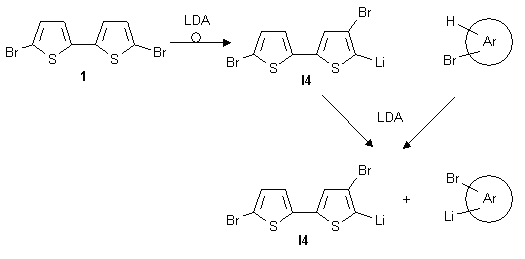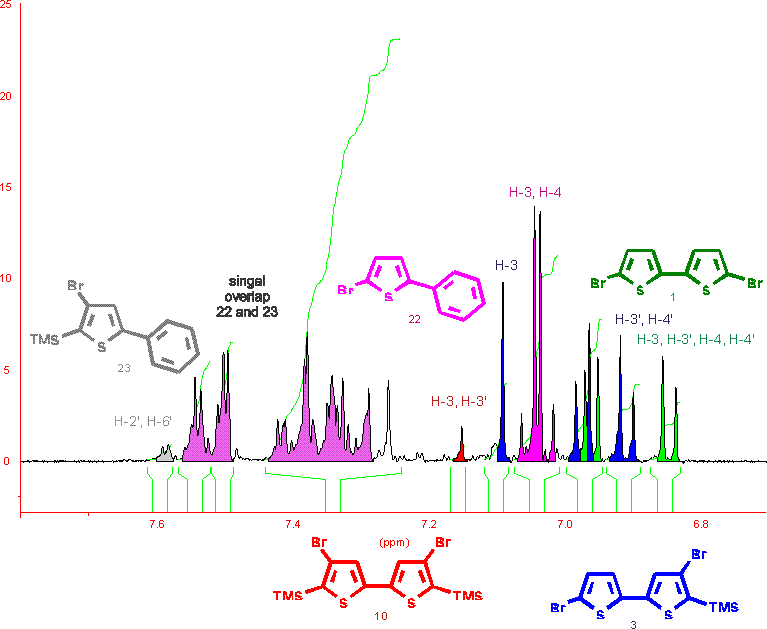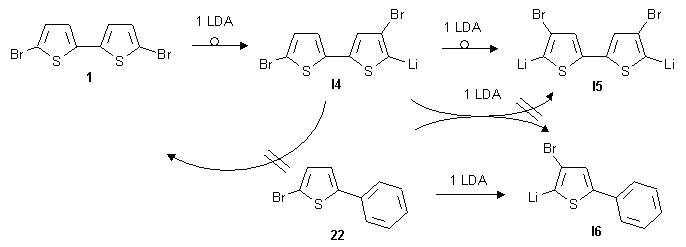Investigation of the lithiation processes involved in Halogen dance
or
Why can mono vs. double migration selectively be controlled?
(Lithium-intermediates trapped as the corresponding TMS-compounds)
At the first glance it was surprising that the investigated migration reactions can be
carried out selectively to afford pure mono-migration products. This only can be rationalized if the
second thiophene-unit is deactivated for further metalations after introduction of the first lithium
atom.

This is known to be true with thiophene itself (2,5-dibromothiophene can be HD-rearranged to
3,5-dibromo-2-lithiothiophene, but not to 3,4-dibromo-2,5-dilithiothiophene) but was not expected
with biaryls.
To prove this assumption, the double-migration reaction was split into two parts: After treatment
of the starting compound 1 with 1 equiv. LDA a second rearrangeable species 22 was added
and a further one further 1 equiv. of LDA was added.

It is important to emphasize that this strategy depends on comparable
reactivity of both 1 and 22, and relies on the absence of side reactions (this had to be
proved).
Therefore, 2-bromo-5-phenylthiophene 22 was chosen as the reaction partner for mechanistic
investigations (which allowed no second metalation under the reaction conditions applied).
Product distribution was determined by HPLC and 1H NMR analysis independently.
Detailed evaluation is shown in ii)
i) Comparison of the reactivity of 0.5 equiv. 1 and 0.5 equiv. 22 with 1.0 equiv. LDA

Result
1 exhibits a higher tendency to rearrange than 22. But the ratio of
conversion can be misleading due to the inhibited second rearrangement step of 1,
thus appearing to be a higher rate of lithiation of 22 (as excess LDA will predominantely force
metalation of a non-lithiated species).
ii) Comparison of the reactivity of 0.5 equiv. 1 and 0.5 equiv. 22 with 0.5 equiv. LDA
This experiment was undertaken to investigate the competition of 1 and 22 for an amount
of LDA insufficient to enable complete metalation of both substrates.

HPLC analysis

NMR analysis

| Product |
LDA via double ended needle |
LDA via Reactor |
| 1H NMR |
HPLC |
1H NMR |
HPLC |
 |
8 |
13.31 |
12 |
16.83 |
 |
38 |
29.89 |
33 |
26.68 |
 |
0 |
4.60 |
3 |
2.50 |
 |
50 |
44.86 |
44 |
44.33 |
 |
6 |
7.35 |
8 |
9.66 |
Result
It turned out (as suggested in i) that 1 is lithiated predominantely over 22.
iii) Exclusion of side-reactions

Result
No side-reactions could be detected.
iv) Competitive lithiation of 0.5 equiv. mono-lithiated I4 and 0.5 equiv. 22 with 0.5 equiv.
LDA

Result
This reaction proves the inhibition of the second lithiation/rearrangement
step, since only trace amounts of 10 could be detected.
v) Summary
It could be shown unambigously that rearrangement of 5,5'-dibromo-2,2'-bithiophene 1 occurs
faster as compared to 2-bromo-5-phenylthiophene 22. Nevertheless the rates are within
the same range.
Rearrangement of 22 is definitely more rapid than that of
4,5'-dibromo-5-lithio-2,2'-bithiophene I4. This can be explained by a strongly reduced reaction
rate for the second metalation step on the 2,2'-bithiophene system, probably caused by extending the
deactivating influence of the lithium atom via conjugation to the second thiophene moiety.















